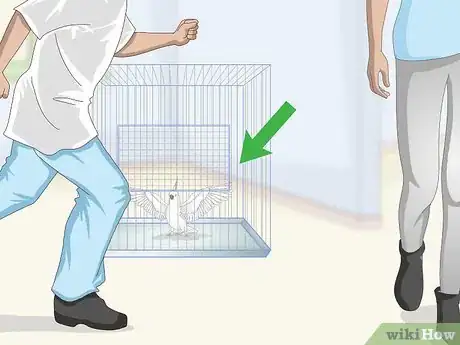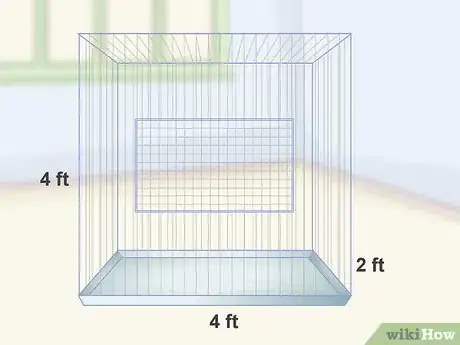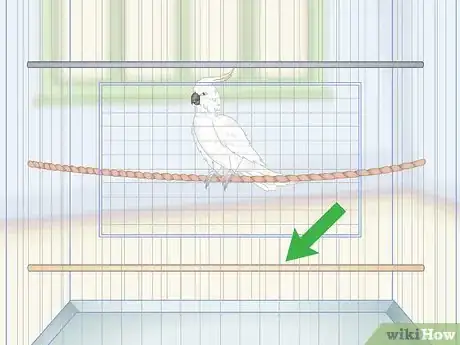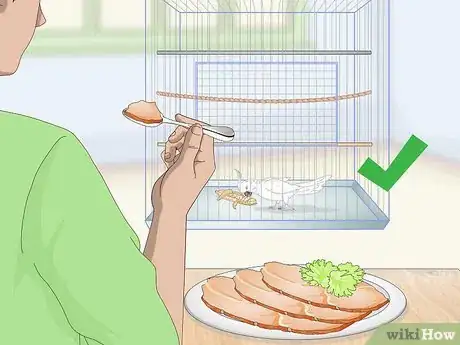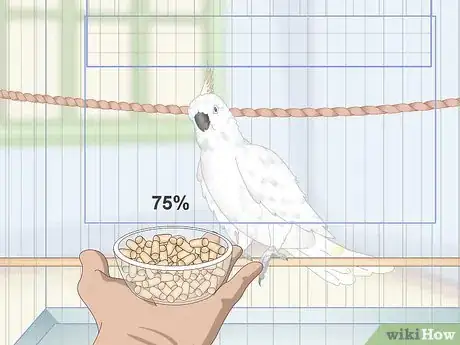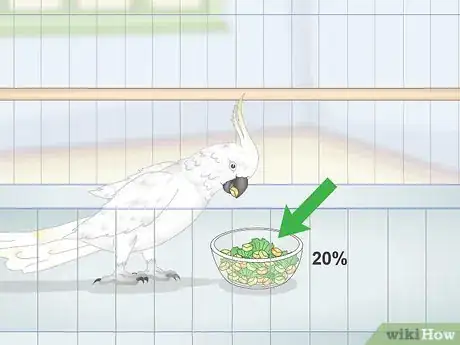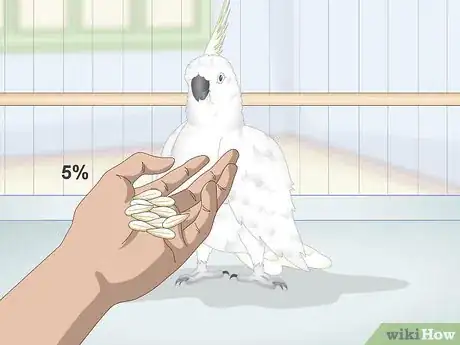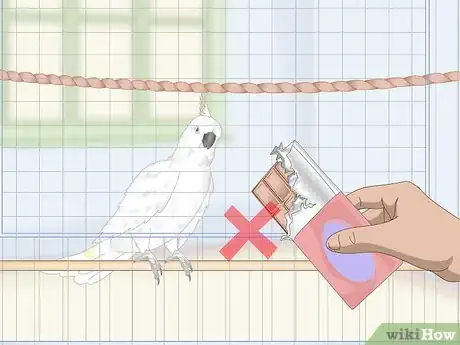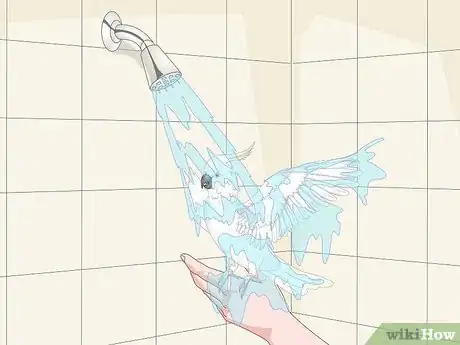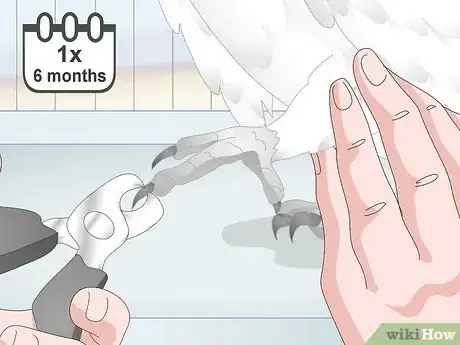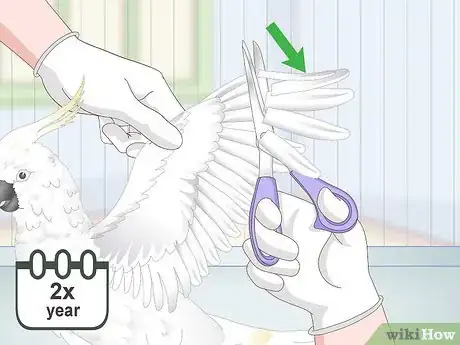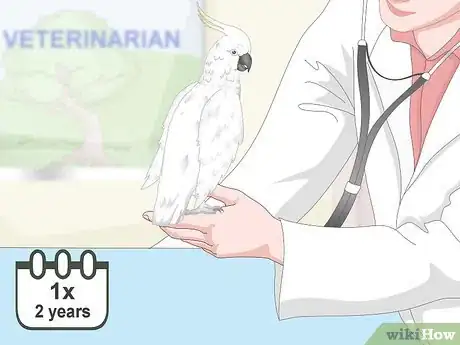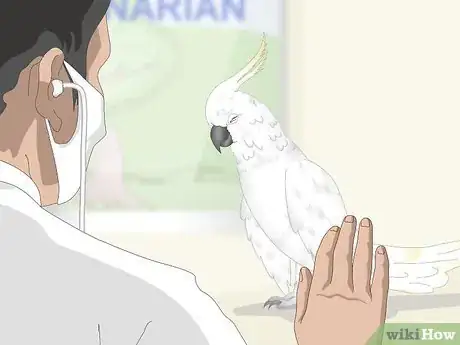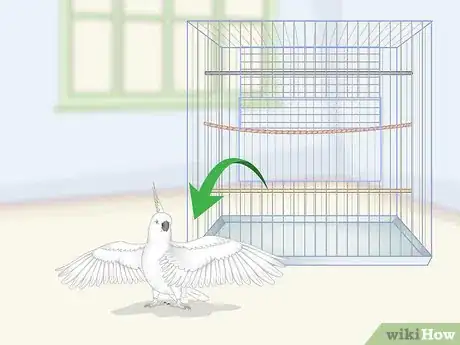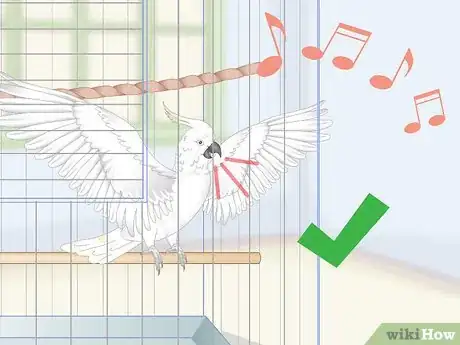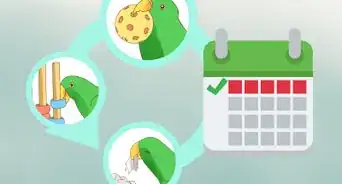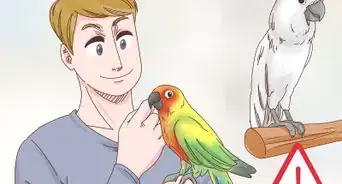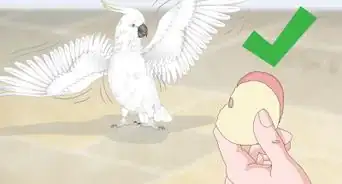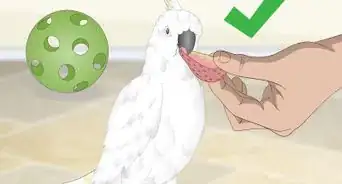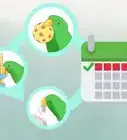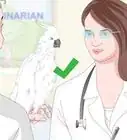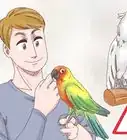This article was co-authored by Hayley Heartfield and by wikiHow staff writer, Danielle Blinka, MA, MPA. Hayley Heartfield is a Bird Specialist and the Owner of About Birds, a Pet Bird Shop in Montgomery County, Texas. Hayley specializes in pet bird care, behavior, training, and breeding. Hayley studied Animal Science at Texas A&M. About Birds carries many species of birds and offers grooming and boarding services as well as bird care products.
There are 11 references cited in this article, which can be found at the bottom of the page.
wikiHow marks an article as reader-approved once it receives enough positive feedback. In this case, several readers have written to tell us that this article was helpful to them, earning it our reader-approved status.
This article has been viewed 122,200 times.
Moluccan and umbrella cockatoos are both larger breeds of cockatoo, growing up to 20 inches (51 cm) tall. Although they are playful, loquacious birds, they're also very noisy and need a lot of attention, as they're more needy than other cockatoos. Keeping your Moluccan or umbrella cockatoo healthy and happy will require a big habitat and a healthy diet. Additionally, you'll need to provide proper grooming and vet care. Finally, treat your bird as a member of the family and provide it with plenty of stimulation.
Steps
Setting Up a Habitat
-
1Place the habitat in a high-traffic area of your home. Your bird needs to feel like part of the family because cockatoos are flock birds. Moluccan and umbrella cockatoos will bond with humans just as they would with fellow cockatoos. Choose a spot near where your family spends time, such as the living room. Put the cage near a window but out of direct sunlight.
- Don't keep your bird in the kitchen. Fumes given off by non-stick coatings can harm your birds health, plus debris from your bird's cage can get on your food.[1]
-
2Choose a cage at least 4 ft (1.2 m) x 2 ft (0.61 m) x 4 ft (1.2 m). Your bird needs to be able to spread out its wings without touching the sides of the cage. Since Moluccan and umbrella cockatoos are large breeds of cockatoo, you may need a larger cage. Choose the biggest one you can afford to keep your bird happy.[2]
- If your bird spends a lot of time in its cage, it needs an even bigger cage. Choosing a cage that's too small will make your bird unhappy, which can lead to behavioral issues like self-mutilation.
Advertisement -
3Provide at least 3-5 wood, rope, and soft perches throughout the cage. Your Moluccan or umbrella cockatoo needs several perches in its cage to give it options for where to rest. Place a soft perch at the top of the cage for your bird to sleep. Additionally, include several natural wooden perches, which allow your bird to rub its nails on the wood and chew on the perch. Additionally, provide your bird with a swinging rope perch to encourage it to get some exercise.[3]
- Plan to replace the perches often, as your bird will likely destroy them over time. Your cockatoo will enjoy scratching and chewing on the perches.
-
4Give your bird 12 hours of light each day. Unlike other parrots, your Moluccan or umbrella cockatoo will sleep as long as it's dark. This is unhealthy for your bird over time. Make sure it gets about 12 hours of light daily so it remains active. Natural light from a window is best, but you can also use artificial light, if necessary.[4]
- Your bird also needs 12 hours of darkness to encourage it to sleep.
Feeding Your Cockatoo
-
1Feed your cockatoo when your family is eating, if possible. In the wild, cockatoos are social eaters, so they enjoy eating together. Your bird will eat more happily if you or your family is eating nearby. Do your best to schedule your bird's meal times at the same time as yours.[5]
- Normally, you'll feed the bird in its cage using food dishes. You don't need to move its cage for feeding time, but it's best if the cage is positioned where it can see you eating.
- Additionally, your bird can also eat a small amount of table scraps, which you can provide either in its food dish or by tossing them to your bird during your meal.[6]
-
2Give your bird specially formulated pellets as 75% of its diet. Pellets are an important part of your cockatoo's diet because they contain the proper nutrition for your bird. Choose a brand that's labeled for use with cockatoos. Put the pellets in a food dish, which you can place in its cage.[7]
- You can find a food dish that's made for use with birds at a local pet store or online. Some of these dishes will look similar to a food bowl made for a cat or dog, only smaller. However, you might prefer a pellet dish that attaches to the side of the bird's cage so your bird doesn't move it around the cage as it eats. The food bowl might be hard to retrieve if your bird pushes it deep into the cage.
- Check the label on your food to find out how much to give your bird. Base the amount of food you give your cockatoo on its weight.
-
3Provide fresh vegetables, legumes, grains, and fruit as 20% of its diet. Not only will these foods provide vital nutrients for your bird, they're also a tasty treat your bird will enjoy eating. Serve cooked and cooled legumes and grains. Choose colorful fruits and veggies to give your bird. Wash the produce, then chop it into smaller pieces before feeding it to your bird.[8]
- Place fresh foods in a separate dish. Remove the dish after about an hour, as the food will spoil.
- As an example, your bird might enjoy eating sliced pineapple, berries, carrots, cucumber, squash and peas. It might also like cooked chickpeas, kidney beans, black beans, and macaroni.
-
4Give your bird treats like seeds, nuts, and table scraps for 5% of its diet. You can sprinkle the treats on your bird's food or give your bird treats during play. Giving your cockatoo treats can be a great way to encourage bonding between you.[9]
- For example, you might use seeds to reward your bird for good behavior. Alternatively, you might give your bird a shelled walnut, which it can crack!
-
5Avoid giving your bird foods that can harm it. Certain foods can harm your bird, so make sure you never feed them these foods. Never give your bird any of the following:[10]
- Chocolate
- Caffeine
- Avocado
- Shelled peanuts
- Potato skins
-
6Provide your bird with constant access to clean water. Attach a small water container on the side of your cockatoo's cage. Replace the water as needed throughout the day. Empty the dish and clean it daily.[11]
- Moluccan and umbrella cockatoos rarely bathe in their water dish, as they prefer to be sprayed with water.
Maintaining Your Bird’s Health
-
1Bathe your cockatoo every other day using a watering can or shower. Pour or spray lukewarm water over your bird while it sits on a stand or on your arm. Your bird will likely move around and spread its wings while it's showering, which is normal and shows it's happy. Don't apply any soap or cleansers to your bird. A typical bath should last 5–15 minutes.[12]
- Keep the water on a low-pressure setting. If the bird's feathers are getting ruffled, the pressure is too high.
- It might take a few showers for your cockatoo to get used to baths. Start out with a light spray of water and gradually progress as your bird gets used to it.
-
2Trim your cockatoo's nails every 6 months at home or the vet's office. Take your bird out of its cage and ask someone to hold it between their hands. Next, identify the nail quick by finding the thin pink vein that runs through the nail. Then, use a guillotine-style clipper to cut of the end of the nail, avoiding the quick.[13]
- You can find nail clippers at your local pet store or online. If you can't find a pair made for birds, it's okay to use one made for dogs and cats.
- If you're trimming your bird's nails at home, buy a powdered clotting agent first, which you can apply to the bird's nail if you accidentally cut the quick. This will prevent excessive bleeding. You can find a powdered clotting agent at a pet store or online.
- Your vet can trim the nails if you're not comfortable doing it.
- Your bird will naturally wear down its nails through clutching perches, playing with toys, and rubbing their claws on surfaces. However, your bird's nails might not get as much wear as a wild bird, meaning its nails need a trimming.[14]
-
3Get your bird's wings trimmed twice a year by the vet. Wing trims keep your Moluccan or umbrella cockatoo from flying too high, which is dangerous for your bird. This is not the same as clipping your bird's wings so it can't fly at all. It'll still be able to fly, just not as well. Moluccan and umbrella cockatoos are large, powerful birds, so you don't want them gaining too much altitude or flying to quickly.[15]
- Your cockatoo will shed its trimmed feathers and regrow new ones about twice a year, which is natural. Make sure you monitor your bird so you can trim its new feathers.
- Your vet can show you how to trim your cockatoo's wings, if you'd like. However, always visit the vet for your bird's first trimming.
-
4Take your bird to an avian vet for biennial checkups. Your bird needs regular vet care to make sure it stays healthy. Your vet will make sure your bird has clear eyes, a healthy coat of feathers, and shows no signs of illness.[16]
- Make sure you find an avian vet, which is someone who specializes in birds.
- When the vet examines your bird, they may decide to do an annual beak trimming. Birds naturally wear down their beaks by chewing, gnawing on toys, and grinding their beak. However, birds kept in captivity may need a yearly trimming. If this is the case, your vet will do it. Never try to do it yourself.[17]
-
5Visit the vet if you notice signs of poor health in your bird. This includes feather plucking, poor beak or feather health, lameness, or obesity. Watch for changes in your bird's appearance, as well as inactivity. Additionally, notice if your bird appears suddenly more aggressive, which might mean it's in pain. If you suspect your bird may be sick, take it to your avian vet immediately. Here are the common ailments among cockatoos:
- Feather plucking and self mutilation: If your bird has this, you'll notice it pulling out its own feathers or picking at itself. This condition can be caused by stress, boredom, itching from parasites, or a bacterial infection.
- Psittacine beak and feather disease: This illness occurs when a circovirus attacks the cells that make up your bird's beak and feathers, causing the beak to be weak and the feathers to grow poorly. You'll notice bald spots, as well as trouble eating.
- Bumblefoot: Your bird's feet might become swollen with lesions on them due to unsanitary cage conditions. This condition may also be caused by dirty perches and poor nutrition.
- Obesity: Birds naturally want to eat a lot, so they can easily become obese if you over feed them. An obese bird will look round about its middle and may struggle to fly more than it used to. This is a serious condition, as it can lead to fatty liver disease, which can be fatal.
- Lipomas: These are fatty deposits that usually appear on your bird's torso. They aren't fatal, but you may get them removed by the vet if your bird appears uncomfortable.
Engaging Your Cockatoo
-
1Give your Moluccan or umbrella cockatoo attention daily to keep it happy. Your Moluccan or umbrella cockatoo would normally form a monogamous bond in the wild. In captivity, your bird will bond with you. It will crave attention from you every day, so make sure you have at least a few hours to spend with your bird each day.[18]
- For example, you might let your bird sit on your arm while you go for a walk or watch television. Additionally, you might play catch with your bird using a small ball or play dress up with your bird using doll clothes.[19]
- Cockatoos are very demanding birds that crave attention. This can lead to bad behaviors like escaping, screaming, and destruction if they're bored and don't get enough attention.
-
2Rotate several sets of toys so your bird stays stimulated. Moluccan and umbrella cockatoos are extremely intelligent, so they need mental stimulation. Both of these breeds are likely to start feather-plucking if they get bored.[20] Giving them a variety of toys can help them stay entertained. Look for toys with moving parts, as well as natural wood toys your bird can chew. Additionally, your bird will enjoy shredding ropes, cardboard, or paper.[21]
- Puzzle toys are a fun challenge for your cockatoo. Some puzzle toys allow you to place a treat inside the toy that your bird will work to retrieve.
- Your bird will get bored with its toys after a week or 2. Keep several sets of toys so you can cycle them. That way, your bird gets “new” toys every couple of weeks.
-
3Let your bird out of its cage for a few hours each day. Always monitor your bird while it's out of its cage so it flies around safely.[22] Before you let out your bird, always bird proof the room(s) it's allowed to enter. Here's how to bird proof a room:[23]
- Turn off ceiling fans.
- Make sure glass windows and doors have smudges so the bird doesn't fly into them.
- Remove, hide or cover electrical wires.
- Avoid using aerosol sprays.
- Blow out or remove candles.
- Avoid using essential oils.
- Clean up and cover flaking paint.
- Remove jewelry, especially costume jewelry, which can contain zinc.
- Put other pets in a different room.
-
4Leave your radio or television on when you're going to be out. Your bird may get lonely if it's left alone. Cockatoos are a flock animal, so they like company. Hearing voices from the radio or television will help them feel like someone is home, even while you're out.[24]
- You don't need to turn up the volume very high. Turn it up just loud enough for it to be audible in the room where your parrot's cage is kept.
-
5Train your bird to scream at certain times of the day. Allowing your bird to scream can help it work off some of its energy. Choose a time that's good for you, such as in the afternoon between the hours of 4:00 pm and 6:00 pm. Teach your bird that it's okay to scream then by turning up loud, high-tempo music. Rile up your bird, then switch to soft music when it's time to calm down. Reward your bird with treats once it's calm.
- Over time, your bird will learn to scream at this designated time. If it's otherwise happy, it's less likely to scream at unwanted times.
Community Q&A
-
QuestionDo umbrella cockatoos need to have oil put on their feet and beaks?
 Community AnswerI have owned an umbrella cockatoo for 20+ years and have never oiled her feet or her beak, nor have I ever heard of doing so.
Community AnswerI have owned an umbrella cockatoo for 20+ years and have never oiled her feet or her beak, nor have I ever heard of doing so. -
QuestionWhat can I give my umbrella that has been vomiting for five days? She still has an appetite, but is quiet and lethargic.
 Community AnswerBring the bird to a suitable veterinarian as soon as possible.
Community AnswerBring the bird to a suitable veterinarian as soon as possible. -
QuestionHow can I train my bird to be quiet when I leave the room?
 Community AnswerAt night when your bird is loud, cover the cage with a blanket (birds tend to be quieter when it is darker). During the day, whenever your bird screams, leave the room, and don't reward it when it screams. When it stops screaming come back and reward it. Birds also tend to be noisy when people are loud.
Community AnswerAt night when your bird is loud, cover the cage with a blanket (birds tend to be quieter when it is darker). During the day, whenever your bird screams, leave the room, and don't reward it when it screams. When it stops screaming come back and reward it. Birds also tend to be noisy when people are loud.
Warnings
- Don't allow your Moluccan or umbrella cockatoo onto your shoulders, as they have a tendency to bite ears.⧼thumbs_response⧽
- Moluccan and umbrella cockatoos are very smart birds that need a lot of stimulation to be happy. Make sure your bird has access to toys and receives lots of attention from you. Otherwise, it might become destructive or aggressive.⧼thumbs_response⧽
- Some Moluccan and umbrella cockatoos are protective of their cages, making it dangerous to take them out. If this is true for your cockatoo, it might be best to have it step up onto a wooden stick rather than your arm. When the cage is out of sight, you can let your bird step onto your arm.⧼thumbs_response⧽
- A screaming Moluccan cockatoo can produce nearly as much noise as a 747 jet, so keep a set of ear plugs to protect your ears. Additionally, take very good care of your bird to minimize squawking.[27]⧼thumbs_response⧽
- Moluccan and Umbrella Cockatoos will create a large amount of powder down to protect their feathers, which can irritate people with allergies.[28]⧼thumbs_response⧽
References
- ↑ https://vcahospitals.com/know-your-pet/teflon-polytetrafluoroethylene-poisoning-in-birds
- ↑ http://www.exoticpetvet.com/cockatoo-care.html
- ↑ http://www.australasianzookeeping.org/Husbandry%20Manuals/Cacatua%20spp%20HG%20EAZA.pdf
- ↑ http://www.exoticpetvet.com/cockatoo-care.html
- ↑ http://www.exoticpetvet.com/cockatoo-care.html
- ↑ https://vcahospitals.com/know-your-pet/cockatoos-feeding
- ↑ http://www.exoticpetvet.com/cockatoo-care.html
- ↑ http://www.exoticpetvet.com/cockatoo-care.html
- ↑ http://www.exoticpetvet.com/cockatoo-care.html
- ↑ http://www.exoticpetvet.com/cockatoo-care.html
- ↑ https://vcahospitals.com/know-your-pet/cockatoos-feeding
- ↑ https://cockatoo-info.com/care/showering/
- ↑ https://www.youtube.com/watch?v=7IphkCpqfj8&feature=youtu.be&t=63
- ↑ https://vcahospitals.com/know-your-pet/beak-and-nail-care-in-birds
- ↑ http://www.exoticpetvet.com/cockatoo-care.html
- ↑ http://aeacarizona.com/Cockatoo_Care_AEAC.pdf
- ↑ https://vcahospitals.com/know-your-pet/beak-and-nail-care-in-birds
- ↑ https://animals.mom.me/behavior-moluccan-cockatoo-4763.html
- ↑ https://animals.mom.me/things-cockatoo-5657.html
- ↑ http://www.exoticpetvet.com/cockatoo-care.html
- ↑ https://animals.mom.me/things-cockatoo-5657.html
- ↑ http://aeacarizona.com/Cockatoo_Care_AEAC.pdf
- ↑ http://www.exoticpetvet.com/cockatoo-care.html
- ↑ http://aeacarizona.com/Cockatoo_Care_AEAC.pdf
- ↑ http://aeacarizona.com/Cockatoo_Care_AEAC.pdf
- ↑ http://aeacarizona.com/Cockatoo_Care_AEAC.pdf
- ↑ https://www.petmd.com/bird/care/all-about-cockatoos
- ↑ https://www.petmd.com/bird/care/all-about-cockatoos
